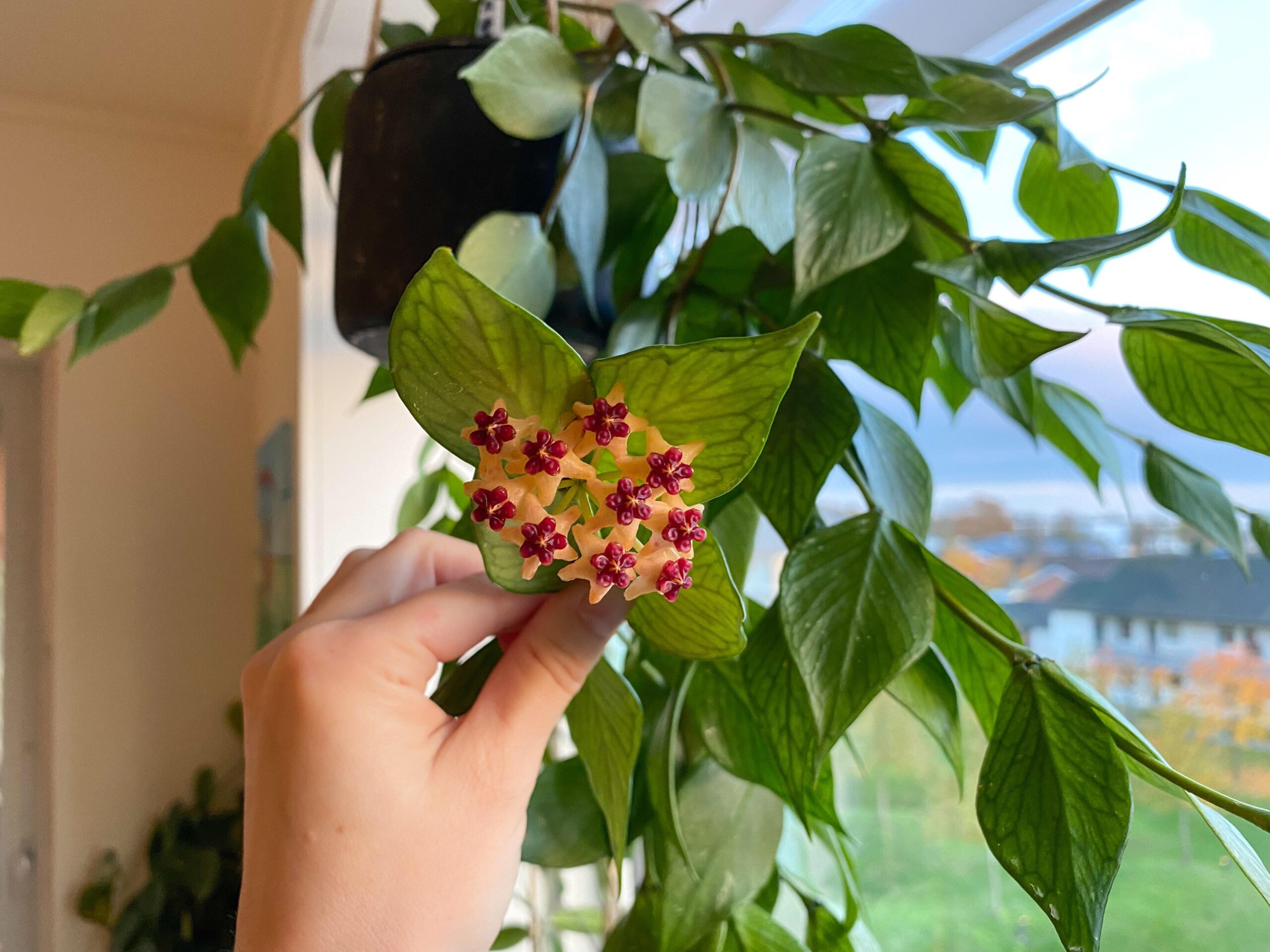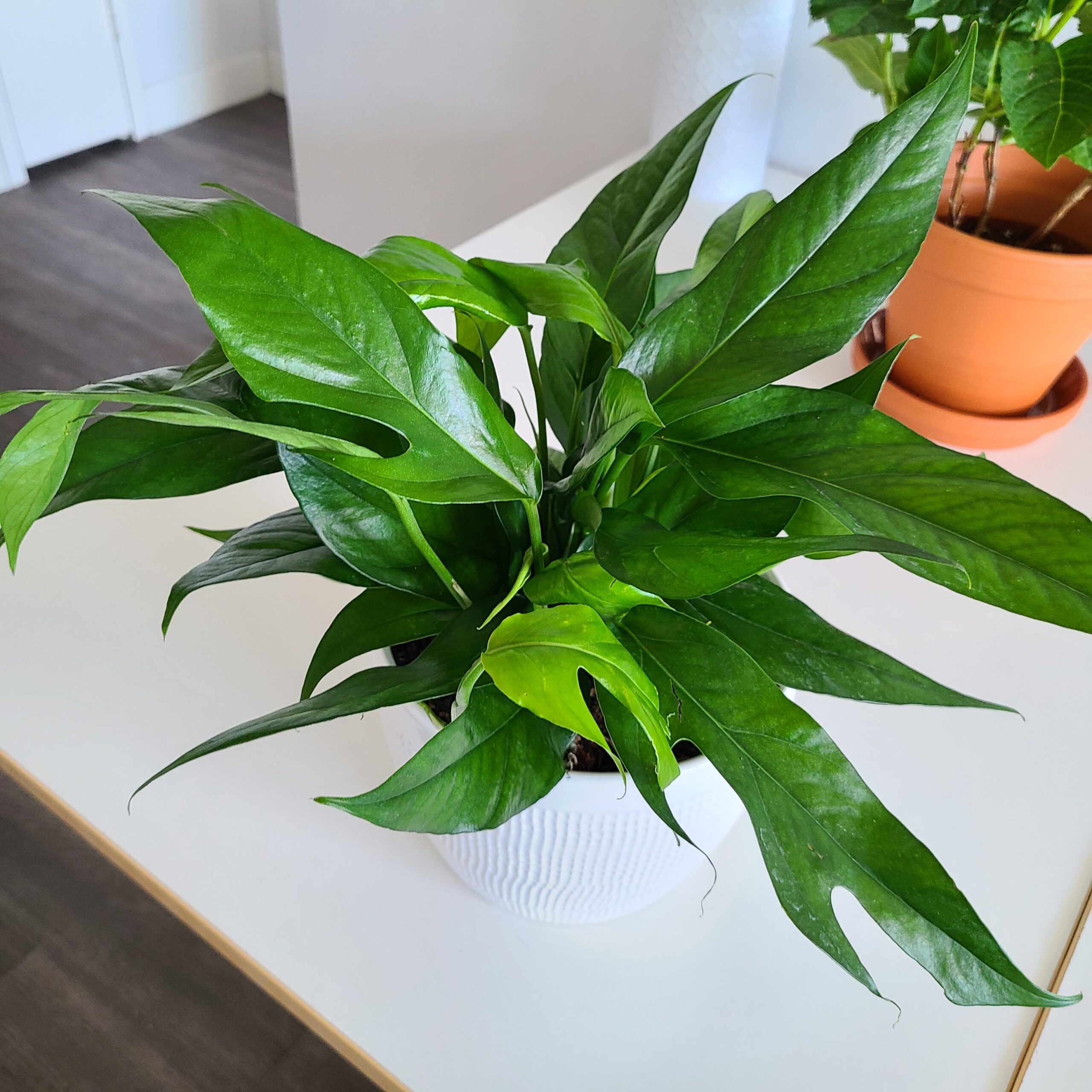The Hoya Polyneura Plant features a fishtail-like venation pattern on leaves and scented creamy- red flowers.
Fishtail Hoya features delicate leaves with a cool fishtail-like venation pattern and produces beautiful star-shaped creamy yellow and red blossoms; hoya polyneura flowers smell strong and spread a pleasant scent. As a member of the wax plant genus, Hoyas are known for their wax-like leaves and are often grown as ornamental plants.
Interestingly, this plant is an epiphytic plant that doesn’t grow in soil but instead prefers to wrap its roots around nearby trees and rocks.

Botanical Name: Hoya Polyneura
Common Name: Fishtail Hoya
USDA Zones: 11 and above (Indoors in zones 4 and above)
Native Area: Southeast Asia
Flower: Green with white or pale yellow with red center
How to Propagate Hoya Polyneura
Propagation from stem cutting in the soil:
- Cut 5 to 8-inch stem cuttings from the tip of the plant’s stems. Remove the leaves from the lower end of the cuttings, leaving the leaves at the top intact.
- Plant the cuttings in fast-draining soil, ensuring that the aerial roots are submerged in the soil and the cuttings are placed 3 inches deep.
- Water the cuttings frequently, and keep the top layer of soil moist.
- Place the pot in an area that receives indirect light to allow for optimal growth conditions.
- Within a month, the cuttings should start developing roots and baby shoots.
- After the root development and the growth of the baby shoots, you’ll have successfully propagated your Hoya polyneura plant.
Propagation from stem cutting in the water:
- Prepare the stem cutting by making a clean cut and allowing the cut end to heal for at least a week.
- Place the cutting in a jar with warm (room temperature) water.
- Be careful not to submerge the leaves in the water, as they should stay dry.
- If you’re using tap water, let it sit overnight to allow any chemicals to dissolve before using it.
- Change the water every few days and be patient as the roots grow, which can take 3-4 weeks.
- Wait until the roots of your plant cutting are at least 3 inches long before transplanting it to a pot.
- When planting, avoid burying the roots too deep in the soil. Instead, gently pack the soil around the base of the cutting to provide support.
Hoya Polyneura Varieties
1. Hoya Polyneura Splash
This variety is a pendant wax plant; the thin, light green leaves have silver splashes.
2. Hoya Polyneua Albomarginata
It features deep green foliage with bright margins.
3. Hoya Polyneura Variegated
This beautiful variety has spotted foliage.
4. Hoya Polyneura Silver
It is a silver version of Hoya polyneura.
5. Hoya Polyneura Broget
It is a hard-to-find variegated plant.
How to Grow Hoya Polyneura

Light
It grows well in bright but diffused light and requires at least 6 hours of it every day. Direct sun and intense exposure, especially in the afternoons or during summer months, should be avoided.
While the plant can tolerate low light, it won’t flower in that environment. To find the perfect spot for your Fishtail plant, place it near a North-facing window.
Water
Hoya Polyneura appreciates moist soil. After watering the soil until it’s completely saturated, let it dry before the next watering. Don’t wait until the soil is completely dry before watering again, and avoid wet, damp, or waterlogged soil.
During spring and summer, it’s recommended to water once or twice a week. However, during colder days, watering once every fourteen to twenty days is sufficient.
Soil
Use soil that drains well. This type of soil prevents overwatering and root rot. If you prefer to use standard potting soil, you can add perlite or sand to improve drainage.
Adding perlite to the soil not only loosens it but also helps retain water because of its porous structure.
Tip: Cactus mix and orchid mix also work well for Hoya plants.
Temperature
It enjoys a temperature between 50 and 77 F (10 and 25 degrees Celsius). However, sensitive leaves can be harmed by extreme temperatures, so it’s important to avoid both scorching and freezing climates.
Humidity
Hoya Polyneura prefers high humidity, which helps it develop lush leaves and blossoms. On dry days, the plant may need extra attention. To increase moisture in the room, you can use a pebble-water tray, a humidifier, or group plants together.
To stop moisture loss, mist the plants occasionally.
Hoya Polyneura Plant Care
Fertilizer
These plants are heavy feeders. If they don’t receive enough nutrients, their leaves may become paler than they should be. During spring until fall, use a balanced liquid fertilizer to provide sufficient nutrients. Remember, excess fertilizer can burn the leaves, so feed moderately.
During winter, the plant won’t require any fertilizer as it will be dormant, resting from all its growth.
Note: To avoid harming your plant, make sure to apply a low-concentration or diluted fertilizer. It’s highly recommended to use organic fertilizers as they are less harsh on the plant.
Repotting
To protect their roots from being too damp, Hoyas prefer a tight-fitting container. Medium-sized pots with drainage holes at the bottom are recommended, and the plant should be repotted every two years.
If the container has bottom drainage holes, you can successfully grow your Hoya Polyneura in terra cotta, plastic, or glazed ceramics.
Pests and Diseases
Indoor plants like Hoya Polyneura can attract various pests, such as mealybugs, spider mites, scale, thrips, aphids, and fungus gnats. However, caring for your plant need not be challenging. The most effective way to control pests is to use neem oil diluted with water and sprayed onto the plant. The heavy oil suffocates most pests, causing them to perish quickly.
Excess moisture due to over-watering, combined with the plant’s preference for high humidity, is a common cause of diseases. To prevent this, avoid using too much water and keep the plant drier.
Read: Hoya Caudata Sumatra Care
Toxicity
Hoya Polyneura is safe for children and pets. Although it is not edible, the plant is also not harmful, so playful chewing or accidental swallowing by small children, dogs, or cats is not a hazard.


